The entire island is a large tuff cone. Daphne Minor, a tuff cone (giant pile of compressed volcanic ash shook like a cone), sits off the north coast of Santa Cruz Island, west of Baltra Island and North Seymour Island. There are no visitor sites on Daphne Minor or Daphne Major islands to be visited on a Galapagos cruise as it is almost impossible to disembark here. The islands only offer visitors some nice dive sites.



The entire island is a large tuff cone. Daphne Minor, a tuff cone (giant pile of compressed volcanic ash shook like a cone), sits off the north coast of Santa Cruz Island, west of Baltra Island and North Seymour Island. There are no visitor sites on Daphne Minor or Daphne Major islands to be visited on a Galapagos cruise as it is almost impossible to disembark here. The islands only offer visitors some nice dive sites.

Santa Fe Island is one in which lavas were extruded beneath the sea and later were uplifted (although recent evidence suggests subsequent sub-aerial activity); the island is crossed by several parallel cliffs formed by fault activity. This island has lavas of 3.9 million years of age, making it the oldest island successfully dated in the archipelago.
Santa Fe Island besides offering one of the more beautiful and sheltered coves in the islands it also has endemic species of land iguana, endemic species of rice rat, subspecies of cacti, beautiful landscape. Its turquoise lagoon is protected by a peninsula of tiny islets forming an ideal anchorage. The island lies southeast of Santa Cruz Island within sight of Puerto Ayora. Geologically it is one of the oldest islands in the archipelago and for many years, was thought to be a product of an uplift event. Through satellite imagery, it has been possible to determine the island's volcanic origins.
A Santa Fe Galapagos travel adventure includes a wet landing on a sandy white beach that brings visitors into contact with one of many sea lion colonies. Bulls contend for the right of being the Beach Master, while smaller males mask as females to make stealthy mating moves. Galapagos hawks are often easily approached, perched atop salt bushes, and an ascending trail leads toward the cliffs, where a dense thicket stands to the inland side. The cliffside provides an expansive view of the ocean. The giant prickly pear cactus found here live up to their name, with tree-sized trunks!
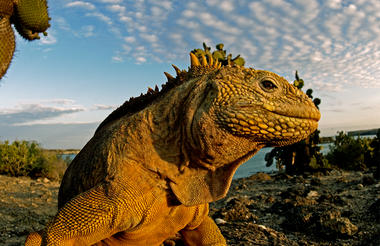
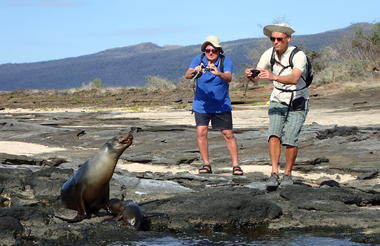

Besides land iguanas, South Plaza has one of the most significant sea lion colonies in the archipelago.
South Plaza Island is one of two small adjacent islets uplifted from beneath the sea by faulting or tectonic activity.
This is the southern partner of two small crescent-shaped islands that lie just a few hundred meters off the east coast of Santa Cruz Island. South Plaza Island is one of the most minor yet richest islands in the archipelago. Only 426 feet, it was formed from uplifted seabed, giving it a titled tabletop quality. Our landing is in the channel between North and South Plaza Island, where the island tilts toward the water.
The approach makes for a lavishly, colorful sight! The turquoise waters of the channel contrast brilliantly with the black lava of the shoreline. The rocks have grown thick with green seaweed in places, speckled with bright orange Sally lightfoot crabs. Further up the shore of South Plaza Island, a carpet of scarlet ice plant (Sesuvium) serves as groundcover for a grove of luminescent green prickly-pear cactus. Yellow-gray land iguanas sit beneath, waiting patiently for pears to drop.
The trail on South Plaza Island gradually follows the tilt of the island to the cliffs that overlook the ocean to the south, where swallow-tailed gulls nest. Red-billed tropicbirds, Nazca, and blue-footed boobies ride the windy currents. An overlook is an excellent place for spotting abundant marine life, including manta rays. Surf pounds an inlet at the western corner of the island, where a colony of male sea lions makes their home at what is referred to as a bachelor's site. The oils from their fur leave the surrounding rocks looking polished and shiny.

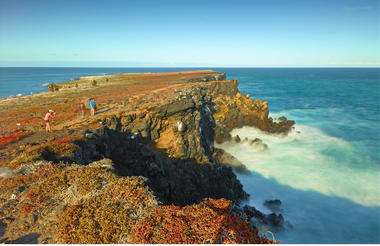
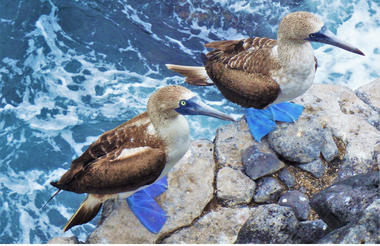
By definition, this is a bird Island! Also known as Tower Island, this island is home to red-footed boobies, masked boobies, frigate birds and swallow-tailed gulls nesting. Moreover, red-billed tropicbirds nest on the cliffs and short-eared owls are often spotted. The vegetation of Tower Island is typical of the Arid Zone, and the tree called palo santo (holy stick) is small in size and abundant.
Genovesa Island lava originated primarily from a crater found in the center of the island, forming a shield volcano. The crater is circular, approximately 2000 feet wide at the rim and 200 feet deep, with a lake 1150 feet across on its floor.
Genovesa Island is possibly one of the most exciting Islands of the archipelago to visit on a Galapagos cruise! It could serve as a film set for a secret submarine base! The southwestern part of Tower Island is an ocean-filled caldera ringed by the outer edges of a sizeable and mostly submerged volcano. The island sits to the northeast, somewhat removed from the Galapagos archipelago. It is also known as "Bird Island," a name it lives up to in a spectacular way. Landing on the white coral sands of Darwin Bay and walking up the beach, you will be surrounded by the bustling activity of magnificent frigate birds.
Puffball-chicks with their proud papas - who sport their bulging scarlet throat-sacks - crowd the surrounding branches, while both yellow-crowned and lava herons feed by the shore. Farther along, you will discover a stunning series of sheltered pools set into a rocky outcrop, forming another natural film set. A trail beside the pools leads up to a cliff overlooking the caldera, where pairs of swallow-tailed gulls, the only nocturnal gulls in the world, can be seen nesting at the cliff's edge. Lava gulls and pintail ducks ride the sea breezes nearby.
Across the bay is Prince Philip's Steps, named for a visit by the British Monarch in 1964. The 81-foot stairway leads to a narrow stretch of land that opens out onto the plateau surrounding Darwin Bay and extends to form the north side of the island. Red-footed boobies wrap their webbed feet around branches to perch in the bushes, and, in contrast, their "Nazca booby" cousins dot the surface of the scrublands beyond. Crossing through the sparse vegetation, you will come to a broad lava field that extends towards the sea-this forms the north shore. Storm petrels flutter out over the ocean in swarms, then return to nest in the cracks and tunnels of the lava field, where their predator, the short-eared owl, is a frequent visitor.



Darwin Bay is a nesting spot for many marine birds. Puffball chicks of Great frigate birds and their proud papas crowd the surrounding branches, while yellow-crowned herons and lava herons feed by the shore. Watch your step for marine iguanas, lava lizards and Galapagos doves that blend with the trail. Swallow-tailed gulls, the only nocturnal gulls in the world, can be seen nesting at the cliff’s edge. Lava gulls and pintail ducks ride the sea breezes nearby.
The island consists of a central volcano and calderas, numerous parasitic cones on the flanks, vast lava fields, and a few vegetated areas. It is one of the youngest volcanoes of the archipelago and the world.
Fernandina Island is the youngest and westernmost island in the Galapagos, which we visit on all our Galapagos cruises. It sits across the Bolivar Channel opposite to Isabela Island. The only visitor site is Punta Espinosa, a narrow spit of land in the northeast corner of the island, where several unique Galapagos species can be seen nearby. As the panga driver skillfully navigates the reef, it is not unusual to see penguins swimming nearby the dinghy. Red and turquoise-blue zayapas (Sally lightfoot) crabs disperse across the lava shoreline, while herons and egrets forage among the mangrove roots.
The landing at Punta Espinosa is a dry one, set in a quiet inlet beneath the branches of a small mangrove forest. A short walk through the vegetation leads to a large colony of marine iguanas - a schoolyard of Godzilla's children - resting atop one another in friendly heaps along the rocky shoreline, sneezing out saline water to clear their bodies of salt. Nearby, sea lions frolic in the sheltered coastline. Fernandina is one of the few places you can glimpse iguanas grazing on seaweed underwater and above!
Dominating this landscape of Fernandina Island is La Cumbre volcano. At 1495 meters ( 4,858 feet ), it is one of the most active volcanoes in the world, reporting seven eruptions from its 6-kilometer-wide caldera (mouth) since 1968. Along the coastline, the world's only species of flightless cormorants have established their colony near an open inlet frequented by sea turtles. Because these birds evolved in Fernandina Island without land predators — it was easier to feed on the octopuses, eels and fish found in the ocean — the cormorants progressively took to the sea. They developed heavier, more powerful legs and feet for kicking, serpent-like necks and wet, fur-like plumage. Their wings are now mere vestiges. Back toward the landing and farther inland, the Fernandina Island's black lava flows become more evident, forming a quiet, inner lagoon. Galapagos hawks survey the seascape from overhead.



Isabela Island is the largest island in the archipelago, accounting for half of the total landmass of the Galapagos at 4,588 square kilometers. Though narrow in places, the island runs 132 km from north to south or 82 miles. Isabela Island is formed from six shield volcanoes that merged into a single landmass. It is also home to the highest point in the Galápagos, Wolf Volcano at 5,547 feet, and calderas of up to 7 miles across.
This Island is formed by five relatively young volcanoes and one, which is very eroded, called Ecuador Volcano. The volcanoes Wolf, Cerro Azul, Alcedo, and the northwestern flanks of Sierra Negra have sporadic activity. The northern volcanoes have broad fields of lava and very little vegetation except for the humid and protected areas.
Located in the south of the northwesternmost point of Isabela Island is Punta Vicente Roca. On the map, this place looks like the head of a sea horse. Here the remnants of an ancient volcano form a cove with a bay well protected from the ocean swells. The spot is a popular anchorage from which to take dinghy rides along the cliff where a partially sunken cave beckons explorers. Nazca and blue-footed boobies as well as brown noddy terns perched along with the point and the sheer cliffs, while flightless cormorants inhabit the shoreline. The upwelling of cold water currents in this part of the Galapagos produces an abundance of marine life which, in combination with the protection of the coves, makes Punta Vicente Roca one of the archipelago's most exciting dive spots where Galapagos sharks and many other sharks are often spotted. This place is right to practice some kayaking. The entire area of Punta Vicente Roca lies on the towering flank of 2,600 foot Ecuador Volcano. This is the island's sixth largest volcano. Half of Ecuador Volcano slid into the ocean leaving a spectacular cutaway view of its caldera.
On the way south of Isabela Island, to Tagus Cove, you will sail through the Bolivar Channel on your Galapagos cruise. These are the coldest, most productive waters in the Galapagos, the upwelling of the rich Cromwell current makes for frequent sightings of dolphins and whales in the area.
Puerto Villamil has a feeling of standing on the edge of the earth. The tiny fishing village, founded in 1897 by Don Antonio Gíl, is something of a forgotten gem in the islands. It has a population of roughly 2,000 people and is set amidst miles of white sandy beaches that rest at the outer edge of 4,452 ft. Sierra Negra Volcano.
Tagus Cove, named for a British naval vessel that moored here in 1814, was used historically as an anchorage for pirates and whalers. One can still find the names of their ships carved into the rock above our landing, a practice now prohibited, of course. The cove's quiet waters make for an ideal dinghy ride beneath its sheltered cliffs, where blue-footed boobies, brown noddies, and pelicans nests. Flightless cormorants and penguins inhabit the lava ledges near the ocean. From our landing, a wooden stairway rises to the trail entrance for a view of Darwin Lake, a perfectly round saltwater crater, barely separated from the ocean but above sea level! The trail continues around the lake through a dry vegetation zone and then climbs inland to a peninsula formed by spatter cones. The site provides spectacular views back toward our anchorage in the bay, as well as Darwin Volcano and Wolf Volcano farther to the north.
Urbina Bay is directly west of Albemarle Island's Alcedo Volcano, where we will make a reasonably easy wet landing (a hop into a few inches of water except when the shoreline is rough) onto a gently sloping inorganic beach. In 1954, a Disney film crew caught sight of this gleaming white strip, and on further investigation found pools of stranded sea creatures! To their astonishment, three miles (5 km) of the marine reef had been uplifted by as much as 13 feet (4 meters) in moments. Now visitors can walk amongst the dried coral heads, mollusks, and other organisms that use to form the ocean floor. A highlight of this excursion is tracking down the huge land iguanas that live in the area, whose vivid and gaudy yellow skin suggests that dinosaurs may have been very colorful indeed. Giant tortoises inhabit this coastal plain during the wet season, before migrating to the highlands when the lowlands turn dry. Our landing beach also provides opportunities to snorkel amongst marine creatures or relax on the beach. Here we must take care not to step on the sea turtle nests, which are dug carefully into the sand.
Buried pirates treasures were unearthed here in Sierra Negra some years ago in the shadow of a tall coconut palm, thereby giving credence to all the legends of hidden treasure buried beneath palm trees. It's possible to travel to the highlands by bus, from the base of the volcano to the Park Service post, from where we can have a 2-hour hike on reasonably steep terrain to the rim of the volcano. Measuring 10 km across, the caldera is the third-largest in the world after Ngorongoro in Africa and Caldera Las Cañadas in the Canarias. At the rim, we have some spectacular views of the caldera, the island, and the surrounding Pacific. We continue hiking for another 45 minutes to the sometimes active cone of Volcan Chico. This is a parasitic cone that protrudes from the northern side of the volcano. The most recent eruption with lava flows and fumaroles occurred in October 2005 and gave evidence of the birth and continued growth of the islands. In the afternoon, we'll return to Puerto Villamil. Along the way, we will visit a breeding station for the endemic giant tortoise lead by the National Park Service as well as a hyper-saline lagoon frequented by flamingos and other waders and shorebirds. We also plan some free time in town giving you the opportunity to relax in a local beachside bar.



As previously described



As previously described



Santiago Island has a volcanic landscape and it is common to see fur seals, flamingos, and hawks. Another important feature of Santiago Island is that it has almost all the vegetation zones, from arid to humid. Still, they have been severely affected by the intense browsing of introduced goats.
Santiago Island offers numerous scoria and tuff cones; extensive recent lava flows on the east and south of the island. One major volcano dominates the western side, which is thickly vegetated and highly eroded.
Just across a narrow channel west of Bartolome Island lies Sullivan Bay on Santiago Island. This landing offers one of the most outstanding volcanic sites in the Galapagos. Just over a century ago, the island gave birth to a field of lava called pahoehoe (“rope-like” in Hawaiian), which gleams like a gigantic obsidian sculpture. It is stirring to imagine the once-molten lava lighting up the earth, flowing into the sea, and sending plumes of superheated steam skyrocketing into the air. The flow gave birth to the new land as it engulfed vegetation, leaving some plants forever etched into the earth.
Today the flow stands as a gallery of abstract shapes resembling braids, curtains, and swirling fans. Brightly colored “painted locusts” and “lava lizards” punctuate the black volcanic canvas, as does the occasional finger of lava cactus and spreading carpetweed. Looking back across the bay from the source of the flow, a cinder cone of reddish lava, you are treated to a view of Pinnacle Rock nearby Bartolome Island.
On the northwestern side of Santiago Island in James Bay, which offers access on a Galapagos cruise to three unique sites, Puerto Egas, Salt Mine, and Espumilla Beach. The first landing, Puerto Egas, is the most visited area and begins with a wet landing on a black beach. With intriguing eroded rock formations inland, the trail crosses the dry interior eastward and continues along the shoreline, where two different types of lavas merge into unreal scenery. There we find the so-called Fur seal Grottos, the only place during your visit that allows you to see these beautiful marine mammals during a land excursion. Darwin describes his visit to Santiago Island and James Bay in Voyage of the Beagle.
From the black beach at Santiago Island, it is possible to experience one of the most exuberant snorkeling sessions during your visit.



As previously described



Located in Santa Cruz Island, the second largest in the Galapagos, Puerto Ayora is located in the southeast of this large, round volcanic island is the economic center of the Islands. It has the largest population among the four inhabited islands (approx. 18,000), which economically relies mostly on tourism—including refurbishing and resupplying Galapagos cruise yachts—along with fishing and boat-building.
Puerto Ayora is home to both the Galapagos National Park Service Headquarters and Charles Darwin Research Station, the center of the great restorative efforts taking place in the park, a UNESCO World Heritage site. Here we go ashore to visit the Giant Tortoise Breeding and Rearing Program run by the research station, which began by rescuing the remaining 14 tortoises on the island of Española in 1970. This program has restored the population of animals there to over 1,000 today. You will see many of these animals, with their sweet ET necks and faces; from hatchlings to juveniles to large, distinguished individuals like Lonesome George, the last of his particular race of tortoises. The local color of this port makes for an attractive stop-off, with restaurants, souvenir shops, and internet cafés
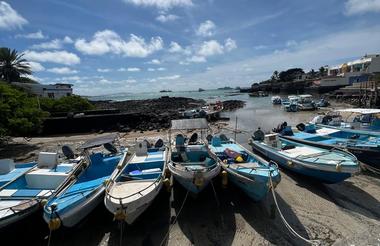


Santa Cruz Island is composed of two parts: a younger and larger portion is formed by many volcanic cones and basaltic lavas, while the older part is a narrow, 10-mile strip of land along the northeastern coast and consists of uplifted submarine lava flows and tuffs.
Santa Cruz Island is the second-largest island in the Galapagos and something of a hub for the archipelago. Puerto Ayora, located in the southeast of this large, round volcanic island, is the economic center of the Islands.
Puerto Ayora is home to both the Galapagos National Park Service Headquarters and Charles Darwin Research Station, the center of the great restorative efforts taking place in the park, a UNESCO World Heritage site.
A highlight of any trip is a visit to Santa Cruz Highlands, where the dry coastal vegetation transitions to lush wet fields and forests overgrown with mosses and lichens. Our destination is the Tortoise Reserve, where we will have chances to track and view these friendly and ancient creatures in their natural settings. This extends to the adjacent pasturelands, where farmers make some profits by allowing visitors into their farms in exchange for payment. The best time to see tortoises here is during the cold or dry season from June through December. Another nearby attraction is the highland lava tunnels. Some of them offer easy access through wooden stairways that descend to the mouth of their arched cave entrances. From there, one can make their way into the caves underground along the cool, dimly lit naturally formed passages with their fascinating rock formations. The tunnels make for a relatively easy and exciting hike. You should bring along non-slip footwear and some hikers prefer to use a flashlight.






